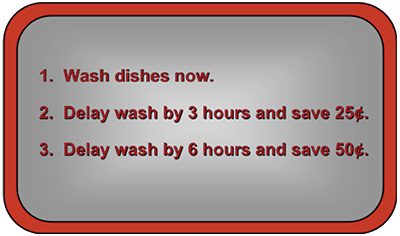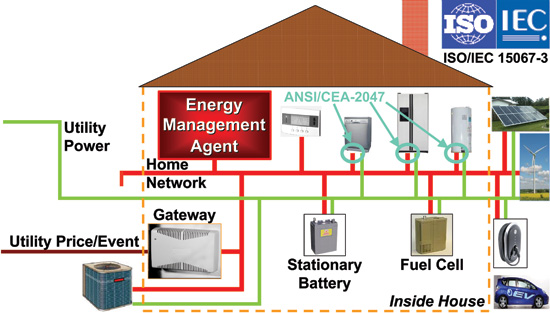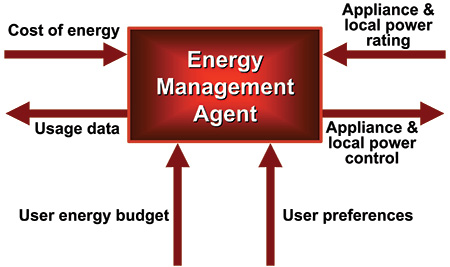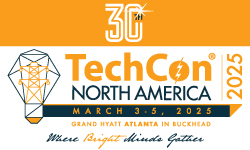Introduction
The Home-to-Grid Domain Expert Working Group (H2G DEWG), part of the Smart Grid Interoperability Panel (SGIP), has participated in the development of a new American National Standard important for smart grid customers. ANSI/CEA-2047, Consumer Electronics – Energy Usage Information (CE-EUI), was published by the Consumer Electronics Association (CEA) in May 2014. The H2G DEWG reviewed the specifications during the drafting of the standard.
The objective of ANSI/CEA-2047 is to specify uniform methods for consumer devices to report energy consumption to an energy management device or service provider via a home network. Consumption data by individual appliances may be useful for augmenting the Green Button program offered by some utilities to educate consumers about their electricity usage. Also, demand response programs can be enhanced with information about appliance consumption so power can be allocated when supplies are constrained or relatively expensive.
Beyond the meter
Traditionally, the electric network terminated at the customer meter. A smart grid can extend information technology (IT) beyond the meter into premises to help manage the demand for electricity from building machinery and home appliances. Also, IT can integrate distributed energy resources (DER) such as solar power, wind turbines, and storage facilities while maintaining a balance of supply and demand on the electric grid.
According to the GridWise® Architecture Council1 (GWAC), IT will revolutionize planning and operation of power grids just as it has changed business, education, and entertainment. IT will enable the integration of new distributed technologies such as Demand Response, distributed generation, and storage with traditional generation, transmission, and distribution assets. The purpose of IT is to improve interoperability among the subsystems that constitute an electric grid. The key challenge2 for the electric industry according to GWAC is how to overlay IT and communication networks on the existing grid while maintaining operations and then enhancing these operations3.
The domain of the traditional electric utility has reached from the generator to the customer meter, as illustrated in Figure 1. The Energy Independence and Security Act of 2007 mandates that utilities manage the grid for increased reliability. IT and data communication networks make this possible.

Figure 1: The Traditional Electric Utility
The IT and communication networks can improve the operation of the traditional parts of the grid. The transmission and distribution grids can be instrumented with sensors for wide area situational awareness that enables remote monitoring via an IT network.
The policy shift away from increasing supply to managing demand requires that the domain of the utility be extended beyond the meter, through a gateway, and connect to a communications network inside the house. From there, utility signals can reach those devices that can participate in energy management. The homeowner may choose to install local power generators such as wind and solar. Thus an integrated smart grid includes the elements shown in Figure 2. A home network can provide the interconnections among the devices in the home involved with energy management.

Figure 2: The Electric Smart Grid
(click to enlarge)
For the grid beyond the meter, IT and communications enable effective energy management using methods such as:
- Demand response
- Integration of local generation and storage with microgrids and the public grid
- Allocating power for electric vehicle charging
Data critical for these functions are drawn from devices in the home that use electric power. Most appliances have a required safety label that lists the maximum power needed so consumers do not overload electrical circuits. However, effective energy management requires data about actual consumption that may vary by operating mode. ANSI/CEA-2047 specifies methods for acquiring more detailed operating data for energy management functions.
ANSI/CEA-2047 functions
ANSI/CEA-2047, the new American National Standard for Energy Usage Information, specifies data acquisition methods while addressing the following challenges:
- The cost of measuring and recording device energy consumption during a specified interval
- The cost of an electronic interface between a consumer device and a home network for reporting device energy consumption
- The complexity of reporting consumption by operating mode and time duration of that model
Consumer markets are very competitive by features and price. Consumers tend to value product features that enhance entertainment and alleviate chores such as washing dishes and clothes. New functions that may reduce energy consumption are difficult to value and to sell. Therefore, the CEA committee responsible for ANSI/CEA-2047 provided options to reduce complexity that could impact product costs. The approach was to acknowledge that some reporting of approximate consumption data was more practical than mandating high precision real-time data.
The ANSI/CEA-2047 standard allows conforming devices to report energy consumption using a range of options with increasing precision. These options accommodate variations in energy consumption of many consumer electronic devices and home appliances according to the mode of operation. For example, a dishwasher uses more energy to dry the dishes than to rinse them. Here are some of the optional reporting methods specified in ANSI/CEA-2047:
- A pre-stored average energy usage for each operating mode
- A pre-stored average power usage for each operating mode multiplied by the duration of that operating mode
- An actual measurement of energy consumed during the time interval of an operating mode
The recipient of energy-consumption messages from the device is responsible for recording and processing the data.
ANSI/CEA-2047 data for energy management
The data provided by consumer devices that conform to the specifications of ANSI/CEA-2047 for reporting energy usage (even if approximate) can enhance energy management using demand response. Demand Response includes programs and technologies to modify customer demand for energy directly by remote control of customer appliances (called Direct Load Control) or indirectly through pricing incentives or event notifications (such as an anticipated heat wave). A framework for Demand Response is included in an international standard, ISO/IEC 15067-3, published by ISO and IEC in June 2012.2
To implement Direct Load Control the utility sends Demand Response control signals to interrupt the operation of selected devices such as air conditioners and water heaters remotely from outside the house. In a typical version of Direct Load Control the utility sends a signal via the power line or a specialized radio to a switch that shuts off air conditioners up to 15 minutes each half-hour for up to six hours each day. Water heaters are generally turned off entirely for two to six hours.
Direct Load Control requires prior arrangements with customers for permission and equipment installation. Direct Load Control has limitations because it treats each type of customer equipment the same. Much more effective Demand Response is possible by exploiting microprocessor-based intelligence at the customer premises using Distributed Load Control. Distributed Load Control afford customers increased flexibility and control compared to Direct Load Control.
With Distributed Load Control utility suppliers do not operate any customer appliances or devices remotely. Instead, they issue a static or dynamic price signal or message that indicates the state of the electricity supply (called an event message). The objective is to influence customer choices about using appliances that consume significant amount of electricity. The price or event messages may include the following:
- Price signals: A multi-level signal that indicates at least two different states corresponding to the electricity price
- Time-of-use pricing: A static rate structure (called a tariff) with specified rates that change at specified times in a repeating pattern such as weekdays and weekends
- ‘Real-time’ pricing: Prices that change dynamically. The specific price, time duration of this price, and amount of prior notification before this price level is in effect vary by utility practice
- Event notices sent by the utility to customers about pending supply limitations that are usually temporary
- Event notices sent by the utility to customers about temporary rate changes.
The utility has the opportunity to change prices when a peak demand is expected. Eventually, utility policy makers would like to adjust prices according to the wholesale market price of electricity to reflect actual utility costs. Appropriately designed smart appliances respond with minimal user involvement or inconvenience.
The following scenario is an example of how a user might interact with an integrated Distributed Load Control system:
It is 4 PM and the user is about to run the dishwasher. The options in Figure 3 might appear on an appliance display panel:

Figure 3: Simple Consumer Choices for Distributed Load Control
The user makes a simple decision based on criteria that are understandable: “Do I need the dishes cleaned in the next three hours (perhaps for a dinner party at 7 PM), or can I wait and save some money?” This makes buying energy as simple as shopping at a retail store.
The introduction of an Energy Management Agent (specified in ISO/ IEC 15067-3) adds functionality to Distributed Load Control by enabling the allocation of limited energy (or a limited budget for energy) among appliances. It may switch energy sources from the public grid to local generators or a battery. As shown in Figure 4, the utility sends pricing data electronically to all houses in real-time via a wide area network. The H2G DEWG has issued a white paper on using broadcast communications facilities for distributing pricing and event data.3 This pricing signal enters the house through a residential gateway. This gateway interconnects a public network using telephone, cable TV, power lines, or radio with a home network. The gateway may be a separate device, as shown in Figure 4, or could be integrated with other gateways, controllers, or even inside an electric meter.

Figure 4: Distributed Load Control with an Energy Management Agent
As illustrated, the consumption data are sent over the home network via a communications interface (specified in another standards issued in 2013: ANSI/CEA-2045, Modular Communications Interface for Energy Management). The Energy Management Agent uses the ANSI/CEA-2047 data to help the occupant determine which appliances to operate while conserving energy and managing energy costs.
Applying ANSI/CEA-2047 data for Demand Response
The Energy Management Agent (EMA) in Figure 4 determines how and when to operate appliances based on the cost of energy, the energy requirements of the appliances, the availability of distributed energy resources (DER – wind, solar, etc.) including stored energy, and user inputs, as illustrated in Figure 5.
Communications between the utility and the EMA consist of the two data flows shown on the left side of Figure 5. The user might specify a monthly energy budget (for example, $100 per month) and preferences (shower at 8 AM, air conditioning at 6 PM, clothes washing after 8 PM, etc.). The customer should always be able to override decisions of the EMA. After processing these data, the EMA issues signals that are distributed over a Home Area Network to the relevant appliances.
The energy requirements of appliances can be provided by messages specified in ANSI/CEA-2047. The algorithm in the EMA might adapt to the precision of the data provided by the networked home electronics and appliances.
The EMA receives the energy pricing and event data, the ANSI/CEA- 2047 data, and users preferences. It acts an intelligent agent for the customer as it processes these data. The EMA is programmed with algorithms, including elements of artificial intelligence, to optimize appliance operation. Smart appliances that can operate in energy conserving modes may improve the effectiveness of a Distributed Load Control system. An EMA is application software that could be located in a personal computer, a cable TV set-top box, or a security system.

Figure 5: Energy Management Agent Parameters
Demand Response, coupled with local intelligence and a home network, should increase residential customer cooperation. The decisions are simple, while consumer privacy and convenience are not compromised. ANSI/CEA-2047 is one of many important standards that enable an effective ecosystem for energy management.
About the Author
 Dr. Kenneth Wacks has been a pioneer in establishing the home systems industry and a management advisor to more than 150 clients worldwide. His business spans home and building systems, utility customer services, and digital entertainment networks (including HDTV and IPTV). His worldview, insights, and expertise are valued by executives for enabling competent decisions on complex technology issues. He also provides due diligence for investors and expert witness services for litigants.
Dr. Kenneth Wacks has been a pioneer in establishing the home systems industry and a management advisor to more than 150 clients worldwide. His business spans home and building systems, utility customer services, and digital entertainment networks (including HDTV and IPTV). His worldview, insights, and expertise are valued by executives for enabling competent decisions on complex technology issues. He also provides due diligence for investors and expert witness services for litigants.
The Consumer Electronics Association chose Dr. Wacks to chair the international committee (ISO/IEC) establishing world standards for home and building automation. In addition, he has written American National Standards in home automation and networked home appliances.
Dr. Wacks serves as chair of the Smart Grid Interoperability Panel (SGIP) Home-to-Grid Domain Expert Working Group (H2G DEWG). The United States Department of Energy appointed him to the GridWise Architecture Council. For electric and gas utilities, he has designed and demonstrated new customer services by linking utility communications with home automation to deliver demand response and value-added services. He received his Ph.D. from MIT as a Hertz Fellow and studied at the MIT Sloan School of Management.
About the Home-to-Grid Domain Expert Working Group
In 2008, the Smart Grid Interoperability Panel (SGIP) Home-to- Grid Domain Expert Working Group (H2G DEWG) was established by the National Institute of Standards and Technology (NIST), U.S. Department of Commerce, and the GridWise® Architecture Council (GWAC), an industry panel of 13 experts appointed by the U.S. Department of Energy. The H2G DEWG is now part of the Smart Grid Interoperability Panel (SGIP), a member-funded, non-profit association created with support from NIST to identify technical and interoperability standards harmonization that accelerates modernization of the grid.
The H2G DEWG scope includes applications and communications linking energy service providers (utilities and other third-party providers) with customer equipment in residential buildings via the electric grid and associated networks. Customer equipment may include home appliances, consumer electronics, plug-in electric vehicles (PEVs), plug-in hybrid electric vehicles (PHEVs), and local power sources (such as photovoltaics). Participants in the H2G DEWG include representatives from utilities, services providers, equipment vendors, and appliance manufacturers. Further information is available at: http://www.sgip.org/home-to-grid-h2g-dewg.
About the Smart Grid Interoperability Panel
The Smart Grid Interoperability Panel (SGIP) is a public-private non-profit collaborative working to identify requirements for interoperability and technical standards. SGIP members work together to accelerate interoperability, testing and certification so that efficient, secure electrical power can reliably maintain and increase standards of living around the world. Members also have privileged access to the collected knowledge and expertise of all the domains in the Smart Grid ecosystem.
References
1 In 2004 the United States Department of Energy created the GridWise Architecture Council to guide the utility industry toward smart grids. The Council consists of 13 experts drawn from the electric and high-tech industries. The author of this paper, Dr. Kenneth Wacks, was appointed to the GridWise Architecture Council to focus on utility services for residential customers including the interconnections of utility networks, home networks, and attached devices.
2 ISO/IEC 15067-3, Information Technology – Interconnection of information technology equipment – Home Electronic System – Application models – Part 3: Model of an energy management system for HES.
3 Broadcast-based H2G Communications Solutions, an SGIP white paper, January 2014. Please see ‘Broad-cast-based Energy Management’ in Energy Central, February 25, 2014 for an overview.









